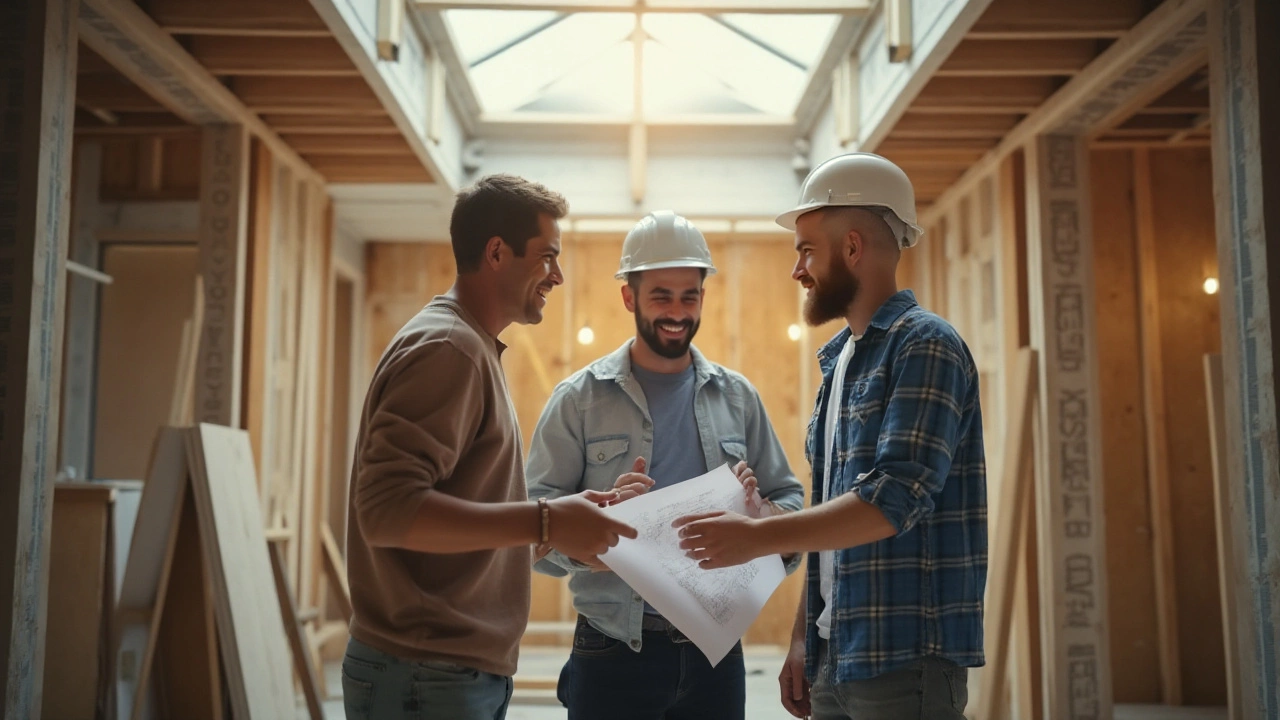Turning an underused loft into a vibrant new space has gained popularity as a home renovation project. By creating additional rooms without expanding the house’s footprint, loft conversions offer an enticing possibility. However, it's crucial to understand the potential drawbacks before eagerly picking up that sledgehammer.
Many homeowners find themselves caught off guard by unexpected challenges that arise during construction. From structural hurdles to budget overruns, these projects might not always go as smoothly as planned. In this piece, we uncover some truths about loft conversions that can help you prepare for a seamless transformation.
- The Structural Challenges
- Costs Beyond Expectations
- Navigating Planning Permission
- Impact on Current Living Spaces
- Addressing Insulation and Climate Control
- Expert Tips for a Successful Project
The Structural Challenges
Embarking on a loft conversion necessitates a clear understanding of your home's foundational integrity. Before transforming your loft, you'll need to ensure that your home's existing structure can bear the new load. The rooftops of older houses, in particular, might not be sound enough to support additional floors or heavy building materials. Hence, a thorough assessment by a structural engineer is non-negotiable. They evaluate the viability and soundness of the space, determining whether reinforcements like steel beams are necessary to carry the weight of new flooring, walls, or integrated utilities.
Architectural designs often significantly influence the scope of necessary structural changes. Consider whether lofty ceilings, skylights, or appealing dormer windows are in your conversion plans. These additions, while enhancing aesthetics, potentially trigger broader modifications to the house’s framework. Alongside creative designs, weightier insulation and required soundproofing can compound these demands. This scenario can escalate into a major structural upgrade, increasing both time and financial investment beyond initial expectations.
The need for a robust structure also extends into the stairway leading to the loft. Traditional homes might possess narrow, steep staircases unfit for safe everyday use. Reconfiguring or entirely installing new staircases is a common requirement within these projects. This adds another layer of complexity - and potential disruption - to the everyday living areas below, affecting family routines and potentially requiring temporary relocation.
"Conducting comprehensive structural assessments before starting a loft conversion isn’t just smart—it’s essential for ensuring future safety and comfort," says Emily Turner, a seasoned architectural engineer with over two decades of experience in domestic renovations.
The structural specifics are also at the mercy of localized building regulations, which may stipulate certain safety enhancements. Compliance with these codes could mean further alterations, especially if you plan to use your loft as a living space, which demands stricter safety adherence. This often involves installing specific types of escape windows or reinforced handrails, thus calling for precise construction standards.
Without doubt, resolving these structural challenges calls for creative thinking and competent execution. Relying on skilled architects and engineers to guide the process helps navigate this potentially murky terrain. In fact, tackling these issues early saves time and resources while delivering a loft conversion that not only meets your spatial needs but ensures your peace of mind. So when contemplating these projects, always stop to consider: Is your home already up to the task?
Costs Beyond Expectations
When embarking on a loft conversion, many homeowners dream of an elegant new space without truly grasping the financial commitment. It often starts with a seemingly straightforward budget, but as the project progresses, hidden costs tend to emerge, potentially stretching budgets to their limits. A wide array of factors can influence the total expense of attic remodeling, from material choices to unexpected structural issues that require immediate attention.
Let's delve into the specifics. Initially, quoting a reasonable price might include just the basics—like initial inspections, basic utility connections, and standard materials. However, once the conversion gets underway, additional needs such as enhanced insulation, sky-high roofing prices, and unforeseen plumbing or electrical rewiring issues arise. Such elements can swell the budget. Homeowners sometimes find themselves faced with bills that are 20% to 30% higher than anticipated.
Construction challenges also play a significant role. In older homes, for instance, reinforcing beams or installing damp-proof membranes might become necessary, and these improvements don't come cheap. Not to mention, sourcing specialty materials, like custom sash windows or bespoke staircase components, can drive costs upward. According to a survey published by Homebuilding & Renovating, the average loft conversion costs can range anywhere from $35,000 to over $70,000 depending on the project scope.
As noted by Henry Pryor, a property expert with significant influence in the industry, "Always prepare for a financial buffer when tackling big remodeling jobs. What you don't want is running out of funds halfway through, leaving your space unfinished."
Moreover, geographical location matters, as construction expenses can vary greatly by region. Consider the availability of skilled labor; hiring experienced workers in urban areas might come at a premium. This variability makes it crucial to conduct thorough research beforehand, obtaining several quotes from different contractors to choose the most economical yet effective option.
Balancing quality and affordability is essential. While opting for lesser-known contractors might initially appear as a smart way to save money, it sometimes backfires when quality issues lead to future repairs or additional hiring to fix initial errors. Instead, working with professionals who have a solid track record in attic remodeling ensures peace of mind and cost-effective solutions in the long run.
For those who seek to economize, intelligent adjustments—like opting for simpler finishing touches, using recycled materials, or handling part of the work themselves —can provide savings without compromising integrity. However, it's vital to be realistic with DIY efforts, as certain tasks, particularly those involving structural modifications or intricate electrical work, require professional expertise. As with all home renovation projects, investing wisely and planning cautiously can help mitigate risks of cost overruns, making your dream loft conversion a beautiful reality.

Navigating Planning Permission
Embarking on a loft conversion necessitates a thorough understanding of planning permission requirements. While it might seem like an uphill task at first, gaining clarity on these legal stipulations early on can save you a world of hassle down the line. In many regions, small conversions fall under the category of ‘permitted development,’ which means they don't need formal permission. However, this can vary significantly depending on where you live and the specifics of your project.
For instance, if your home is located in a conservation area or is a listed building, you might need additional approvals. It's crucial to check the rules set by your local planning authority, as they can impose restrictions about the height and shape of your conversion. Sometimes, these rules can dictate even finer details like window specifications and the materials you may use. Skipping this step can result in costly alterations later, or, worst-case scenario, being ordered to undo the work completely.
One often overlooked aspect is communicating with your neighbors. Considering the large-scale work involved, including noise and disruption, discussing your plans with them beforehand can smooth out potential disagreements. You might not require their formal approval, but surprisingly, many disputes arise out of a lack of communication. Ensure that your designs comply with what's known as ‘the right to light,' which could impact how the conversion proceeds.
Besides the local laws, having an architect or a professional with expertise in attic remodeling design review your plans can be highly beneficial. They can foresee issues you might miss, including those relating to building regulations beyond planning permission. Regulations covering structural integrity, insulation, and even emergency exits must be adhered to, ensuring the converted space is safe and livable.
According to a survey published by the Royal Institute of British Architects, ‘87% of homeowners underestimated the importance of technical standards in construction projects,' reiterating the necessity for professional guidance in such vital endeavors.
It's also practical to consider the timeline for obtaining approval. Depending on the complexity and jurisdiction, this process can range from a few weeks to several months. Therefore, incorporating potential delays into your project timeline helps prevent unexpected setbacks. In addition, some homeowners opt for pre-application advice, which involves seeking initial feedback from the planning authority. Though often carrying a fee, this step can guide you in aligning your designs with regulatory expectations right from the get-go.
Seeking Legal Advice
The benefits of hiring a planning consultant cannot be overstressed, particularly for larger or more complicated home renovation projects. These professionals offer insights into the intricate world of planning and building regulations, aiding not just in compliance but optimizing the design for best value. Their expertise can sometimes mean the difference between a quick, smooth project and one mired in bureaucratic red tape. Consider the investment in their guidance as a pivotal part of your renovation budget.Impact on Current Living Spaces
When considering a loft conversion, one factor that should not be overlooked is how it could affect your current living arrangements. This is particularly important since the changes can have significant repercussions on daily life. As you transform an attic into a usable space, the rest of the home may need to adapt to accommodate these new conditions. One immediate impact might be seen in the redistribution of available square footage and how it affects the flow of your existing rooms.
An important aspect is the integration of the staircase leading to your new loft area. Placement of such a staircase might require sacrificing a portion of an existing room, often a bedroom or hallway, thus altering the spatial dynamics of the original floor plan. Picking the most strategic location and design for this staircase is key to maintaining harmony within your home environment. This can sometimes involve creative solutions, perhaps opting for spiral or space-saving stairs instead of more traditional designs.
Architectural Digest advises, "Choosing a well-designed staircase is crucial, as it impacts not just functionality, but also the aesthetic feel of all connecting spaces."
The impact extends beyond physical space. A change in layout can also affect light and acoustics within your home. For example, converting the loft frequently necessitates new or larger windows. While this can introduce additional natural light to the upper space, it can potentially reduce the light flow to other rooms depending on the home's design. Such modifications might require additional adjustments, like painting walls in lighter colors or adding more interior lighting, to compensate for any newfound shadows.
Noise transfer is another factor to consider. Introducing a new active space directly above bedrooms or living areas could initially disrupt the tranquility of existing rooms. Soundproofing solutions, like insulated floors or acoustic panels, may help create an effective buffer, ensuring that each area of the home remains as peaceful as possible. The need for such measures can vary extensively based on the age and materials of the original build. Investing in these solutions early on can save you plenty of potential frustration down the line.
Ventilation and heating also require careful consideration. The introduction of a new room can upset the balance of your home's heating or cooling systems, potentially necessitating upgrades to handle the additional demand. Extending existing HVAC systems or installing separate units could help maintain comfort. It's wise to consult with a professional to evaluate your current system's capacity before moving forward. As a helpful tip, many homeowners report that investing in energy-efficient insulation within the loft aids not only in climate control but also in energy savings over time.
The decision to undertake a loft conversion presents a wonderful opportunity to enhance your home, but it can also present nuanced challenges that may not be evident at first glance. By contemplating the repercussions on existing living spaces beforehand, and perhaps enlisting a designer's eye, such challenges need not be daunting. Instead, they become a part of crafting a well-thought-out transformation that adds true value to your home life.

Addressing Insulation and Climate Control
When it comes to transforming lofts, insulation and climate control stand as significant considerations that can greatly affect the comfort and efficiency of the new living space. A well-designed insulation system is not just about keeping the space warm in winter and cool during summer; it also plays a vital role in soundproofing and energy conservation. Proper insulation is essential since lofts are notably vulnerable to temperature fluctuations due to their position directly beneath the roof. With the sun beating down during summer or howling winds in winter, a loft can easily become uncomfortable if not properly insulated. Even minor gaps can lead to significant heat loss and increased energy bills, making it crucial to focus on airtightness when planning your home renovation.
One effective method is installing a layer of thermal insulation under the roof tiles. This not only helps in maintaining a balanced indoor temperature but also contributes to the longevity of the roof structure by preventing dampness and mold formation. Many homeowners opt for foam boards or spray foam as they provide excellent thermal resistance. According to the U.S. Department of Energy, a well-insulated attic can save between 10-50% on heating and cooling costs—a testament to its importance. Consider also adding reflective insulation to block radiant heat transfer, especially if your region experiences extreme temperatures.
"A well-insulated home not only ensures comfort but also significantly reduces our carbon footprint," says John Williams, a leading expert in sustainable design. "Investing in quality insulation is a smart choice for both the environment and your wallet."
Another aspect to consider is artificial climate control using efficient HVAC systems. While natural insulation helps manage the overall thermal environment, integrating modern climate control systems can offer additional comfort. This includes installing energy-efficient windows and ventilators that facilitate adequate airflow while minimizing heat loss. In terms of layout, opening up the loft space underlines the strategic placement of vents and air ducts to ensure effective airflow. Using programmable thermostats along with ceiling fans can regulate temperature efficiently without resorting to excessive energy use.
Moreover, addressing ventilation is imperative to avoid condensation issues. Without proper airflow, condensation can lead to damp patches and even structural damage over time. Ensuring that the loft space includes air bricks or mechanical ventilation systems can help keep the space dry and extend the life of your loft conversion. Whether you’re embracing radiant floor heating or solar roofing panels, understanding how to control the loft environment is a key component that will save you time, hassle, and money. By considering these aspects thoughtfully during construction, you can ensure that your loft conversion is not only expanding your living area but also enhancing your home's energy efficiency and comfort.
Expert Tips for a Successful Project
When diving into a loft conversion project, the road to success is paved with meticulous planning and informed decisions. The first step in ensuring a smooth transition involves a thorough assessment of the space. Architects and structural engineers can evaluate your attic’s current condition, identifying any necessary changes to support the newly renovated area. This step is not only critical for safety but also informs the overall design and functionality of the space.
Budgeting is another critical element. Beyond the initial costs, keep a contingency fund of at least 10-15% of the total project cost. This cushion accounts for unexpected expenses, which, as many homeowners learn, are an inevitable part of such projects. Speaking of budgets, opting for high-quality materials, especially for insulation and climate control, can drastically reduce future energy bills and maintenance costs. According to the National Association of Home Builders, energy-efficient homes can save homeowners over 30% annually on utility bills.
Hiring the right professionals is crucial. An experienced contractor with a proven track record in attic remodeling ensures skilled labor and adherence to local building codes. Word-of-mouth recommendations or thorough vetting on online platforms can help identify reliable professionals. Ensure they have valid insurance to prevent unforeseen liabilities during the construction phase. As noted by construction expert Jane Smith, "The key to a successful renovation lies in finding that balance between creative design and technical feasibility."
"The key to a successful renovation lies in finding that balance between creative design and technical feasibility." - Jane Smith, Construction Expert
Attention to detail can make all the difference. While converting your loft, think about how the room will be used — bedroom, office, or playroom — and plan the wiring, plumbing, and lighting accordingly. A sustainable approach, investing in energy-efficient fixtures and appliances, can considerably enhance the room’s usability. A well-placed skylight or roof window not only saves energy by maximizing natural light but also adds an architectural flair that transforms the ambiance of the room.
Finally, it’s important to comprehend the legal aspects. Research any planning permissions or restrictions that apply to your area. While many home renovation projects fall under ‘permitted development’, some may require permits due to changes in the structure, such as raising the roof height. Consulting the local planning authority can provide clarity and prevent legal hiccups.
| Aspect | Importance Level |
|---|---|
| Space Assessment | High |
| Budget Planning | Medium |
| Permit Compliance | High |
| Material Quality | Medium |
In summary, a successful loft conversion requires balancing creativity with practical considerations. By laying a strong foundation through informed planning, budget foresight, and expert advice, homeowners can transform unused spaces into valuable, functional living areas.

Written by Fletcher Abernathy
View all posts by: Fletcher Abernathy